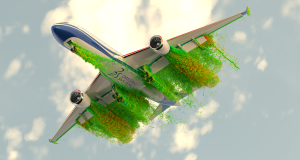Want to learn more about SIMULIA’s fluid solutions and capabilities including PowerFLOW? Visit our page.
Most of us are used to flying, and few of us think about the many factors that affect an aircraft’s performance. We spend a few hours in the air, and if we’re lucky we experience a smooth ride with minimal turbulence. However, for the engineers and designers responsible for creating these aircraft an immense amount of work goes into ensuring that these flights are as safe and smooth as possible, with optimal speed and efficiency.
An aircraft’s performance must be assessed at every stage from takeoff to landing, including its behavior on the ground, while gaining altitude, while cruising and while descending. For example, engineers must be able to predict how the aircraft will react to the onset of buffet at high speeds or the effects of drag on the landing gear. As aircraft designs become faster and more efficient, it is critical for engineers to understand high-speed and high-lift characteristics. In addition, it is extremely important to understand the effects of aerodynamic degradation on aircraft performance in icing conditions.
Simulation allows engineers to anticipate the performance of aircraft with reduced physical testing, like expensive and time-consuming wind tunnel and flight tests, and with lower risk. Aerodynamic performance characteristics can be developed and virtually validated using 3D models rather than physical prototypes, which saves money and time and provides manufacturers with an edge over the competition in terms of innovation, efficiency and time to market.
SIMULIA fluids solutions offer a complete portfolio of appropriate fidelity computational fluid dynamics methodologies. These technologies utilize Navier-Stokes based solvers for cruise conditions and Lattice Boltzmann solvers for unsteady simulations such as high-lift configurations and high-speed buffet and stall. Compared to physical testing, these simulation solutions offer greatly reduced turnaround time, earlier population of the aerodynamic database and an overall lower risk to the program.
Engineers using SIMULIA fluids solutions can establish confidence in the real-world performance of aircraft before that aircraft ever leaves the ground. Lattice Boltzmann-based CFD are several times faster than traditional unsteady CFD methodologies, and SIMULIA fluids solutions allow for the use of higher fidelity CFD methodologies in early development stages.
As aerospace and defense becomes an increasingly competitive field, speed in developing products is obviously important, but fast development time means nothing if regulations are not met, and as aircraft become more high-tech, regulations get more strict. SIMULIA fluids solutions are designed to predict the complex physics that involved in satisfying those regulatory requirements, including those involved in take-off, landing and climb performance, stall characteristics, high-speed characteristics and buffeting.
SIMULIA fluids solutions are in the process of becoming fully integrated with the 3DEXPERIENCE platform, and are currently available on the SIMULIA Cloud for easy access without the need for hardware. This means that companies of any size can benefit from comprehensive simulation technology without having to make a major investment.
The aerospace and defense industry is ever-growing, with new companies arising to challenge the big corporations that have been in place for decades. Both these new companies and these established corporations must be constantly improving and updating their technology in order to stay competitive, all while meeting regulations. SIMULIA fluids solutions and the 3DEXPERIENCE platform can meet those needs, helping the industry to grow and advance with minimal investment of time and money. Simulation is becoming less of an option and more of a requirement in the development of aircraft, and aerospace engineers will benefit greatly from a solution that covers every aspect of an aircraft and its movement.
Want to learn more about SIMULIA’s fluid solutions and capabilities including PowerFLOW? Visit our page.

